Practical Excel skills sharing: Quickly create folders in batches!
Creating one folder is a trivial matter; creating ten folders is completed quickly; creating 171 folders is a big project. If batch creation is not possible, it would be good if it can be completed in 2 hours. This article will introduce to you how to use Excel to create folders in batches. I hope it will be helpful to you!

# After receiving a small request from the leader, create a folder according to the directory in the picture below. The editor silently counted and found that almost 171 folders need to be created. A small task can become a large project in seconds.

So, what should you do if you encounter such a large folder project? The answer is to use the MD command for batch processing.
1. Know the MD command
Md (make directory) is a command used to create a directory in the DOS operating system. The Md command can be used to create multi-level directories.
Format: md [path] directory 1 directory 2 directory 3...
Let’s test whether MD can really create multi-level directories.
Step one: Press the WIN R key on the keyboard, enter CMD, and then press the Enter key to open our DOS window.
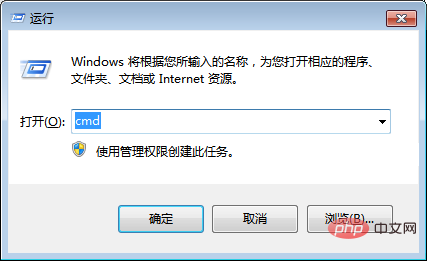
Step 2: Enter the MD command, then press the space bar, and then enter the multi-level directory "Directory 1 Directory 2 Directory 3 Directory 4". After completing the input, press the Enter key to execute the DOS command.

Go to the C:UsersAdministrator folder and the newly created multi-level folder already exists, perfect!

If we can create MD commands in batches and then copy and paste them into the DOS window, we can solve the need to create a large number of folders.
2. Use EXCEL to batch generate MD folder creation text
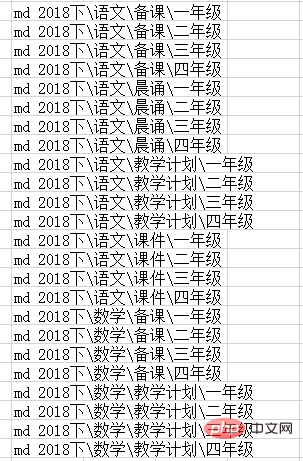
Step 1: In EXCEL according to the leadership requirements, Organize folder names according to the levels of first-level directory, second-level directory, and third-level directory. If you need to create a folder, enter 1 in the corresponding cell; if you do not need to create a folder, enter 0 in the corresponding cell. For example: first and second graders of information technology do not need to create folders, just enter 0 in the corresponding cells.
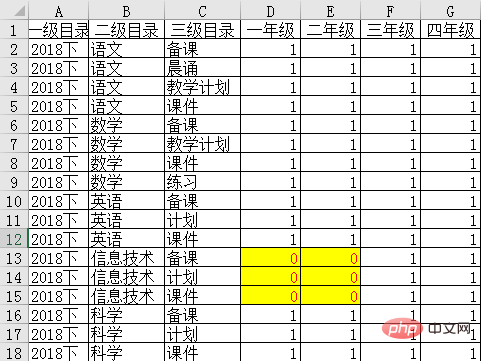
Step 2: Save the newly created EXCEL file.
Step 3: Perform unpivot operation on the data area.
(1) Create a new worksheet.
(2) Select the "Data" tab, and then select "New Query" -> "From File" -> "From Workbook".
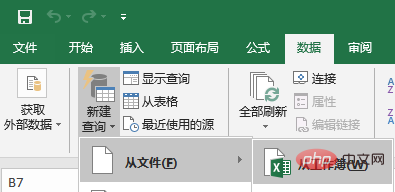
(3) Select the EXCEL file saved above and click the "Import" button
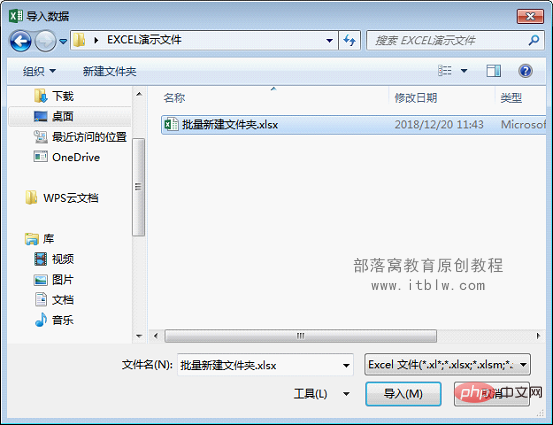
(4) Select Select the worksheet where the data is located, sheet1, and click the "Edit" button.

(5) Hold down the Shift key to select the 4 columns of data for first grade, second grade, third grade, and fourth grade, right-click and select "Inverse Pivot Column".
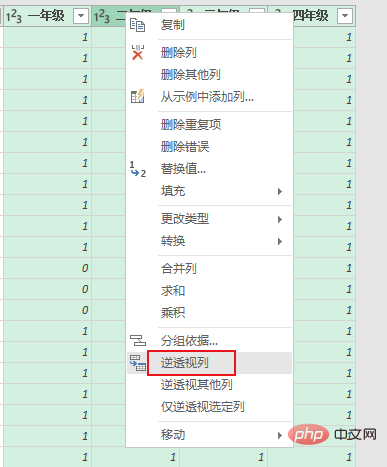
(6) Select "Close and Upload".
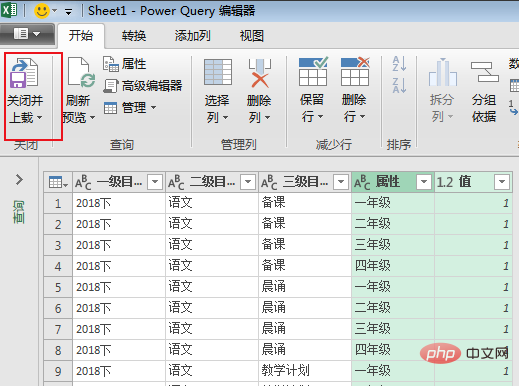
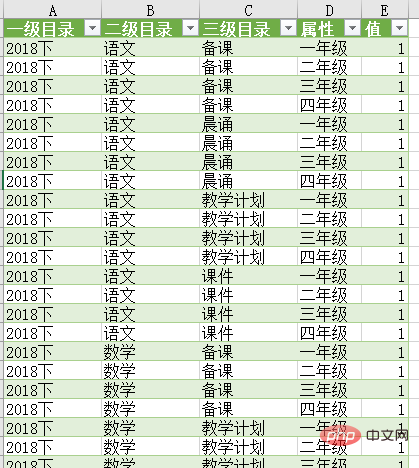
(7) Next, you only need to perform string concatenation. Enter the formula in F2:
="MD
"&A2&""&B2&""&C2&""&D2
Then fill in the formula downwards to get the command line for MD to create all folders.
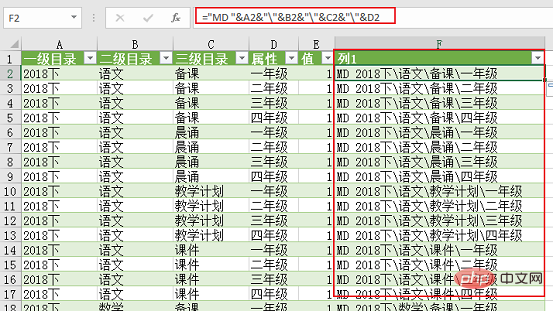
3. Complete the batch creation of folders
(1) Copy all the concatenated strings in column F.
(2) Return to the DOS operation window , paste into the DOS window.
Note: You cannot directly press Ctrl V to paste, but you should right-click the mouse and select the "Paste" command to paste.

Folders have been created in batches, as follows.
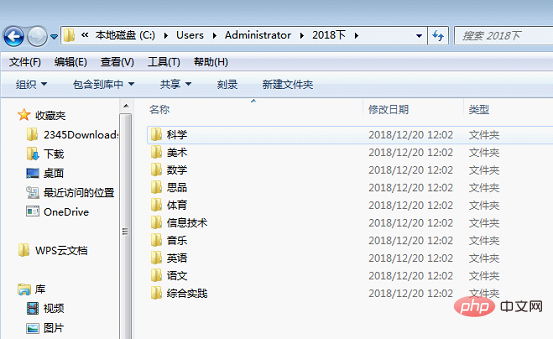
Postscript:
Some partners may ask: What should I do if I need to create a folder under the F drive?
Simple, in the DOS window, first enter "F:" and press Enter to enter the root directory of the F drive, then follow the above operation and copy and paste.
My partner continued to ask: I need to create a folder under the "Teaching" folder on the D drive, and I don't want to enter DOS commands. What should I do?
is also very simple! Create a new text file through Notepad, and copy and paste the MD command string prepared above into the text file.
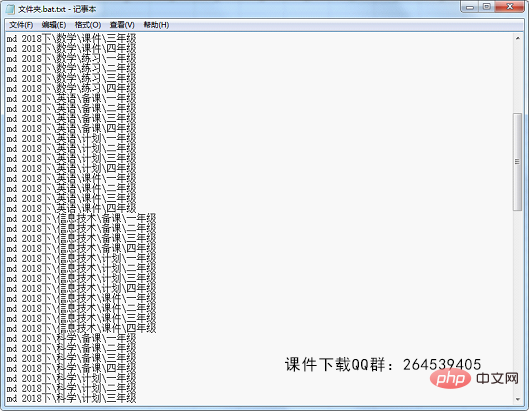
Then save the text file. After saving, right-click the file and select "Rename" to modify the file extension from .txt to .bat. The bat file is a batch file.
Next, put the file with the modified suffix where you need to create a folder, double-click it to generate folders in batches. For example, if you place it in the root directory of drive F, folders will be generated in batches in the root directory of drive F; if you place it in the "Teaching" folder of drive D, you will be able to batch generate folders in the "Teaching" folder.
Related learning recommendations: excel tutorial
The above is the detailed content of Practical Excel skills sharing: Quickly create folders in batches!. For more information, please follow other related articles on the PHP Chinese website!

Hot AI Tools

Undresser.AI Undress
AI-powered app for creating realistic nude photos

AI Clothes Remover
Online AI tool for removing clothes from photos.

Undress AI Tool
Undress images for free

Clothoff.io
AI clothes remover

Video Face Swap
Swap faces in any video effortlessly with our completely free AI face swap tool!

Hot Article

Hot Tools

Notepad++7.3.1
Easy-to-use and free code editor

SublimeText3 Chinese version
Chinese version, very easy to use

Zend Studio 13.0.1
Powerful PHP integrated development environment

Dreamweaver CS6
Visual web development tools

SublimeText3 Mac version
God-level code editing software (SublimeText3)

Hot Topics
 1389
1389
 52
52
 What should I do if the frame line disappears when printing in Excel?
Mar 21, 2024 am 09:50 AM
What should I do if the frame line disappears when printing in Excel?
Mar 21, 2024 am 09:50 AM
If when opening a file that needs to be printed, we will find that the table frame line has disappeared for some reason in the print preview. When encountering such a situation, we must deal with it in time. If this also appears in your print file If you have questions like this, then join the editor to learn the following course: What should I do if the frame line disappears when printing a table in Excel? 1. Open a file that needs to be printed, as shown in the figure below. 2. Select all required content areas, as shown in the figure below. 3. Right-click the mouse and select the "Format Cells" option, as shown in the figure below. 4. Click the “Border” option at the top of the window, as shown in the figure below. 5. Select the thin solid line pattern in the line style on the left, as shown in the figure below. 6. Select "Outer Border"
 How to filter more than 3 keywords at the same time in excel
Mar 21, 2024 pm 03:16 PM
How to filter more than 3 keywords at the same time in excel
Mar 21, 2024 pm 03:16 PM
Excel is often used to process data in daily office work, and it is often necessary to use the "filter" function. When we choose to perform "filtering" in Excel, we can only filter up to two conditions for the same column. So, do you know how to filter more than 3 keywords at the same time in Excel? Next, let me demonstrate it to you. The first method is to gradually add the conditions to the filter. If you want to filter out three qualifying details at the same time, you first need to filter out one of them step by step. At the beginning, you can first filter out employees with the surname "Wang" based on the conditions. Then click [OK], and then check [Add current selection to filter] in the filter results. The steps are as follows. Similarly, perform filtering separately again
 How to change excel table compatibility mode to normal mode
Mar 20, 2024 pm 08:01 PM
How to change excel table compatibility mode to normal mode
Mar 20, 2024 pm 08:01 PM
In our daily work and study, we copy Excel files from others, open them to add content or re-edit them, and then save them. Sometimes a compatibility check dialog box will appear, which is very troublesome. I don’t know Excel software. , can it be changed to normal mode? So below, the editor will bring you detailed steps to solve this problem, let us learn together. Finally, be sure to remember to save it. 1. Open a worksheet and display an additional compatibility mode in the name of the worksheet, as shown in the figure. 2. In this worksheet, after modifying the content and saving it, the dialog box of the compatibility checker always pops up. It is very troublesome to see this page, as shown in the figure. 3. Click the Office button, click Save As, and then
 How to type subscript in excel
Mar 20, 2024 am 11:31 AM
How to type subscript in excel
Mar 20, 2024 am 11:31 AM
eWe often use Excel to make some data tables and the like. Sometimes when entering parameter values, we need to superscript or subscript a certain number. For example, mathematical formulas are often used. So how do you type the subscript in Excel? ?Let’s take a look at the detailed steps: 1. Superscript method: 1. First, enter a3 (3 is superscript) in Excel. 2. Select the number "3", right-click and select "Format Cells". 3. Click "Superscript" and then "OK". 4. Look, the effect is like this. 2. Subscript method: 1. Similar to the superscript setting method, enter "ln310" (3 is the subscript) in the cell, select the number "3", right-click and select "Format Cells". 2. Check "Subscript" and click "OK"
 How to use the iif function in excel
Mar 20, 2024 pm 06:10 PM
How to use the iif function in excel
Mar 20, 2024 pm 06:10 PM
Most users use Excel to process table data. In fact, Excel also has a VBA program. Apart from experts, not many users have used this function. The iif function is often used when writing in VBA. It is actually the same as if The functions of the functions are similar. Let me introduce to you the usage of the iif function. There are iif functions in SQL statements and VBA code in Excel. The iif function is similar to the IF function in the excel worksheet. It performs true and false value judgment and returns different results based on the logically calculated true and false values. IF function usage is (condition, yes, no). IF statement and IIF function in VBA. The former IF statement is a control statement that can execute different statements according to conditions. The latter
 How to set superscript in excel
Mar 20, 2024 pm 04:30 PM
How to set superscript in excel
Mar 20, 2024 pm 04:30 PM
When processing data, sometimes we encounter data that contains various symbols such as multiples, temperatures, etc. Do you know how to set superscripts in Excel? When we use Excel to process data, if we do not set superscripts, it will make it more troublesome to enter a lot of our data. Today, the editor will bring you the specific setting method of excel superscript. 1. First, let us open the Microsoft Office Excel document on the desktop and select the text that needs to be modified into superscript, as shown in the figure. 2. Then, right-click and select the "Format Cells" option in the menu that appears after clicking, as shown in the figure. 3. Next, in the “Format Cells” dialog box that pops up automatically
 Where to set excel reading mode
Mar 21, 2024 am 08:40 AM
Where to set excel reading mode
Mar 21, 2024 am 08:40 AM
In the study of software, we are accustomed to using excel, not only because it is convenient, but also because it can meet a variety of formats needed in actual work, and excel is very flexible to use, and there is a mode that is convenient for reading. Today I brought For everyone: where to set the excel reading mode. 1. Turn on the computer, then open the Excel application and find the target data. 2. There are two ways to set the reading mode in Excel. The first one: In Excel, there are a large number of convenient processing methods distributed in the Excel layout. In the lower right corner of Excel, there is a shortcut to set the reading mode. Find the pattern of the cross mark and click it to enter the reading mode. There is a small three-dimensional mark on the right side of the cross mark.
 How to insert excel icons into PPT slides
Mar 26, 2024 pm 05:40 PM
How to insert excel icons into PPT slides
Mar 26, 2024 pm 05:40 PM
1. Open the PPT and turn the page to the page where you need to insert the excel icon. Click the Insert tab. 2. Click [Object]. 3. The following dialog box will pop up. 4. Click [Create from file] and click [Browse]. 5. Select the excel table to be inserted. 6. Click OK and the following page will pop up. 7. Check [Show as icon]. 8. Click OK.




